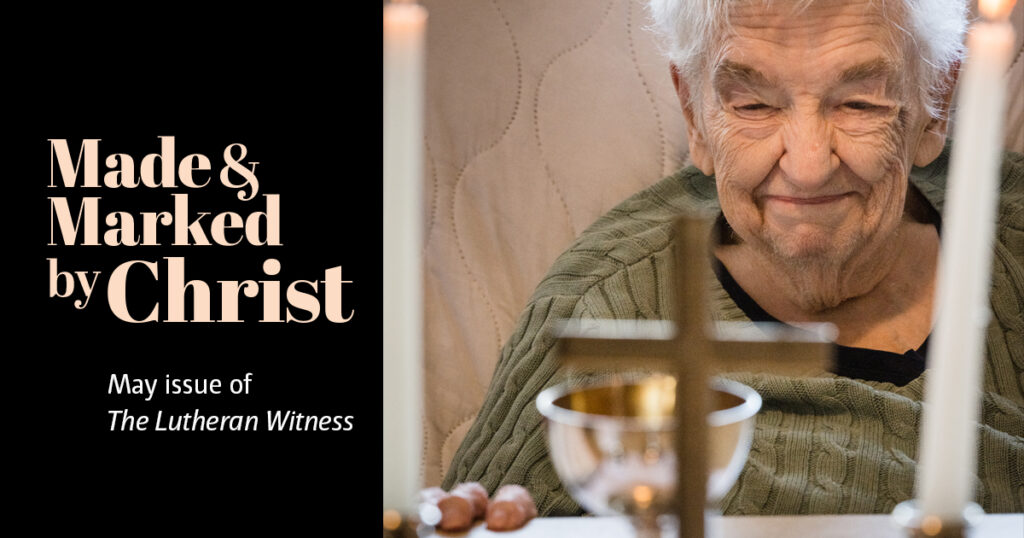Lively Word and Sacrament ministry
By Stacey Egger
Across the country, LCMS congregations are facing declining and aging membership, a shortage of pastors and financial strain. As of 2016, the median age of our adult members was 56, with 30% of our membership older than 65, and 58% older than 50.[1] Further, 57% of our pastors are over the age of 55 (and only 23% are under the age of 45).[2] Rural, small-town and metropolitan congregations all feel this strain. And yet, amid the struggle, none of the congregations in the LCMS is alone. The history of the church includes many eras in which congregations outnumbered pastors. In the time of the apostles, pastors traveled miles to multiple congregations. The history of the LCMS — both national and international — contains many similar stories. Now congregations are embracing such models again.
Of the 5,876 member congregations and new church starts of the Synod, 1,094 (or 18.6%) are already part of a multi-congregation parish (MCP).[3] There are 519 MCPs, made up of two, three or four congregations. They are in every district, and 22 districts have at least 10. And there will be more.
Statistically, such partnerships are succeeding in their purpose. An MCP congregation is significantly less likely to be vacant than a single congregation of the same size.[4]
District presidents, pastors of MCPs and other leaders from across the LCMS believe that MCPs are succeeding in many other ways as well. Over and over again, they point out: These partnerships, if approached rightly, serve not as a tourniquet on a wound but as a positive blessing to the church. They can help congregations thrive in their work, refocus on what it means to be the church and remain in place with a lively presence of Word and Sacrament ministry.
When to start looking at partnership
“God makes us all partners by the Gospel,” said the Rev. Dan Galchutt, assistant to the LCMS Kansas District president for missions and stewardship.[5] “We want to encourage all of our congregations to think about partnerships as early as possible — not just out of necessity.”
Every congregation, said Galchutt, should consider partnering with others to steward resources well and work together as the church. Joint church events or youth groups, a joint secretary or other staff member — such things can bless both congregations and lay the groundwork for further partnership in the future.
Usually, MCPs form when one or more of the congregations is unable to support a full-time pastor. District leadership can help congregations sort through factors such as costs versus income, visitor numbers and new member numbers. Often, the restructuring happens when a pastor takes a call or retires.
Certainly, congregations do not need to wait for such a moment to form an MCP. The guiding question should be: Would our congregation carry out its ministry better in partnership with another?
Types of partnership
The LCMS Kansas District has created resources that lay out models for some of the common types of congregational partnerships (available at kslcms.org/partnerships). These models include:
- Dual parish: Two (or more) congregations of a similar size partner in ministry.
- Helping hand: A larger congregation assists a smaller one.
- Circuit rider: A pastor serves several small churches.
- Multi-site: Congregations form one entity with multiple ministry sites.
The appropriate model for a congregation may depend more on location and context than on preference. What congregations are around you? What size are they? Are there any that you would work well with?
Here are a few examples:
In Montana, the Rev. John Vallie serves a tri-parish that is a 300-mile round trip. Faith Lutheran in Glasgow, Trinity in Wolf Point and Trinity in Plentywood each have about 15–20 worshipers on a Sunday. Vallie preaches and celebrates the Lord’s Supper at a different congregation each week and livestreams the sermon to the others.
In Iowa, the Rev. Jonathan Conner serves Zion in Manning. Zion, while not a part of a formal dual parish, is in “partnership” with Trinity in Manilla. When Trinity had trouble filling a vacancy, Zion provided financial assistance, allowing Trinity to call her own pastor. In exchange, Zion receives support from Trinity’s pastor and partnership with Trinity. Services, events and programs are held jointly or at non-overlapping times.
In Connecticut, the Rev. Evan Scamman accepted a call five years ago to a dual parish in Greenwich, located two miles apart. After three slow, careful years of discussion, First Lutheran sold its beloved building and joined St. Paul Lutheran.
In northern Minnesota, the Rev. Karl Weber serves St. John’s Lutheran in Ottertail and St. Paul in Richville. They are 11 miles apart and St. John’s (about 100 on Sunday) pays the majority of the expenses, while St. Paul (about 25 on Sunday) pays a smaller portion.
Successful partnerships
While MCPs vary greatly, what makes them successful boils down to three central points:
1. Keep the mission at the center.
As congregations face declining numbers, sometimes lapsing into “survival mode” feels inevitable. For instance, 57% of Montana congregations have fewer than 50 in attendance, according to the Rev. Terry Forke, president of the LCMS Montana District. “It’s easy to slip into survival mode — ‘just keep the doors open until I get buried.’”
But partnerships forged on economic fear are not set up for success or survival.
“The healthy attitude is: We get to cover a lot of ground and maintain the proclamation of the Gospel in varied places and as congregations we want to do that together,” said Forke.
From the beginning, congregations involved in partnership should pray and study the Word of God together. “You will find lots in there about God’s people working together,” said Galchutt.
2. Set clear expectations ahead of time.
MCPs should create a detailed and unified plan in advance, usually in the form of a Multi-Point Parish Agreement. A sample agreement is provided in the LCMS Council of Presidents Manual, which includes:[6]
- pastoral duties and expectations;
- congregational expenses;
- service times; and
- the structure and organization of the MCP.
“Pastors can come and go,” said the Rev. Dwayne Lueck, president of the LCMS North Wisconsin District, so it is important to make sure congregational leaders are on board with everything.
3. Communicate clearly.
Partnerships thrive when everything is out in the open.
It is crucial that “there are no hidden agendas,” said the Rev. John Pingel, president of the LCMS Eastern District. “All of the issues should be out on the table. … We must deal honestly with each other.”
The best way of doing this is to foster personal relationships between the congregations, especially their leaders. Regular meetings of congregational leadership are important, and regular fellowship events for the congregations are very helpful.
Communication from the pastor is also crucial. For instance, he can hold regular “office hours” at each congregation and advertise these times in the church bulletin.
Obstacles to partnership
Just as partnerships succeed in similar ways, the same obstacles seem to arise everywhere. Here are a few that came up again and again:
1. Congregational identity
Many of these congregations have decades, if not centuries, of history. For some members, this history intertwines with generations of family history.
Sharing a pastor with another congregation can feel like a threat to this identity, especially if it means compromising on some of those traditions. Further, entering a partnership often requires replacing a past identity that members may be holding onto.
“Almost every member of either congregation remembers a time when there was standing room only on Easter Sunday, and when there were 30 people in the children’s Bible class,” said Scamman. “People have to grieve what was lost.”
2. Service times
Scheduling service times usually requires sacrifice by at least one congregation. Sometimes it means a service at a time other than Sunday morning.
“Everyone seems to want the Divine Service at ‘the divine time of 9 a.m.,’” said the Rev. Justin Panzer, president of the LCMS Kansas District. “How do we be flexible for the sake of the kingdom of God?”
When it comes to these practical details, it is difficult for congregations to sacrifice their routine practices.
3. Pastor’s time, residence and attention
When a pastor shepherds two or three or four congregations, tensions can arise over his work and his whereabouts. How often is he in our church office? If he lives in another town, do those members have more access to him? Are we getting what we’re paying for?
This can be especially difficult in partnerships where a larger congregation pays a larger portion of the pastor’s salary.
Congregations may also struggle with the loss of many services that their pastor once provided. A congregation unprepared to assume more of these tasks will likely feel a loss or overburden their pastor.
4. Prior community tensions
One district president shared a story of a congregation that was resisting partnership for months. He couldn’t understand it. Finally, an elder clued him in: “We can’t partner with them, they’ve been our rivals in football for years.”
Sports rivalries in rural and small-town settings — and all manner of other cultural rivalries in all settings — can pose real obstacles to partnership.
Facing the obstacles, refocusing on the mission
These obstacles, difficult as they are, can in fact bless the church as congregations work through them.
The formation of multi-congregation parishes gives congregations the opportunity to refocus on what the church is, what the pastor is for, and how they should work together as brothers and sisters in Christ and members of a Synod.
“We build our identity around so many things that are ultimately not Jesus,” said Conner. “If we can refocus on our mission and the ministry that God is doing in our buildings and out from us, we’ll find more we agree upon than we don’t.”
For example, multiple service times can have advantages, when they are not on Sunday. While not ideal, in an increasingly secularized world many end up with Sunday morning obligations. A Saturday night service can be a great blessing.
When the pastor’s time is constrained, both he and the congregation must focus on what he is really there for — and these things become valued as the primary things they are. The members, in turn, step up to fill other roles.
“These congregations become a lot more self-sufficient,” said the Rev. Brady Finnern, president of the LCMS Minnesota North District. “They are expecting their pastor to be their pastor, primarily.”
The pastor must “show up, preach, lead study, preside over the Sacraments,” said the Rev. Michael Lange, president of the LCMS California-Nevada-Hawaii District. Other responsibilities can be taken up by the congregation: visiting and caring for members, leading home studies, secretarial work, proclaiming Christ to their neighbors and performing acts of mercy.
Partnerships also require congregations to look outside of their isolated existence and to consider what the church is.
Manning and Manilla, Iowa, are small towns that were “arch-rivals” for years, said Conner. “To watch these two churches in these two towns partner together has been amazing. They have risen above the historic conflict to celebrate what God is doing in these two locations.”
“It’s really how circuits and the Synod are meant to work anyway,” said the Rev. Todd Kollbaum, director of LCMS Rural and Small Town Mission.
“We need each other, whether we are in partnership or just neighbors,” said the Rev. Sean Daenzer, who is the director of LCMS Worship and previously served a dual parish in the North Dakota District. A dual parish can be “the first step in broadening our horizons to see that there are Christians all around the world and that we are truly united,” he said.
We need each other. MCP congregations understand this inherently.
The Rev. Mark Wiegert serves a tri-parish in Lewistown, Stanford and Denton, Mont. One year, when the Denton congregation sustained significant hail damage, the other two congregations covered an extra share of expenses. Another year, Denton ended up with a surplus and shared it with the Stanford congregation, which was struggling that year. “We do bear one another’s burdens, no doubt,” said Wiegert.
A blessed end
Keeping a struggling church open is not always the best option. However, there are many, many situations in which it is.
In Kansas, said Panzer, as in many places, often the closure of a congregation means the loss of an LCMS presence in an entire county. In Montana, it can mean “hundreds of miles without anyone proclaiming the Gospel,” said Forke. And maintaining a place where the Gospel is being proclaimed is full of promise.
“Just because a congregation enters a dual parish, doesn’t mean it’s permanent,” said Panzer. “The unchurched are everywhere. … The harvest is ripe.”
There are, of course, times when closure is inevitable. When lay leaders are tired and no one new is stepping up, a congregation can’t pay its utility bills, or a building is decrepit beyond the point of affordable repairs, a partnership may not be the way forward.
But even such difficult cases can witness to the reality of Christ’s church, as these congregations learn that they have not “failed.”
“Where is that first church in Jerusalem that the apostles started?” said Scamman. “It’s gone. The building is gone, the people are gone. And yet the church is thriving — the Church Triumphant only grows. If we can remember the 200 people that used to be here and now they’re all with Christ, that’s mission accomplished. That’s the church’s job on earth: that the last member be ushered into the kingdom of God, and our Lord returns. Then we close shop, lock the doors. We don’t need these buildings on earth anymore.”

This article originally appeared in the May 2023 issue of The Lutheran Witness.
Note: An earlier version of this article mistakenly said that St. Paul Lutheran in Greenwich had sold its building and joined First. This has been corrected.
[1] Pew Research, “Which U.S. religious groups are oldest and youngest?” pewresearch.org.
[2] LCMS Rosters and Statistics, “Analysis of Ordained Ministers: Age, Status, Calls, Retention and Placement,” September 2022.
[3] MCPs are often referred to as “dual parishes,” but the official term “multi-congregation parishes” is used in this article, as some include three or four congregations.
[4] LCMS Rosters and Statistics, “LCMS Multi-Congregation Parishes,” Feb. 28, 2023.
[5] Galchutt now serves as executive director of the LCMS Office of National Mission.
[6] This is available online as a part of the LCMS Kansas District’s partnership resources.






Thank you Stacey Egger! This is an excellent and timely article. The article complements and reinforces several themes we discussed on April 15, 2023 in a local joint gathering, “Talking About Tomorrow,” put together by the Visitors of Texas District Circuits 1, 2, and 3. This article is a great service to us as we reflect on the changes before us. The timing is most providential.
The church has endured centuries of demographic changes, economic struggles, and cultural lethargy, especially during times of prosperity, when communities begin to feel self sufficient and forget God. The Old Testament gives us a record of the behavior of the children of Israel, and the New Testament reveals similar struggles the church endured. And through the ups and downs, our faithful Lord gives us shepherds to lead the flocks of His fold, both large and small congregations. I have noticed in the LCMS church I attend that refugees from other lands, legal immigrants who have made America their home, and been coming to Christ, bringing their children as well. They sit in the pews next to the elderly members, who are being called Home one by one. It is a good thing to see. I know it is the Lord’s doing, and this is why we must understand that He is the one in charge. Soli Deo Gloria.